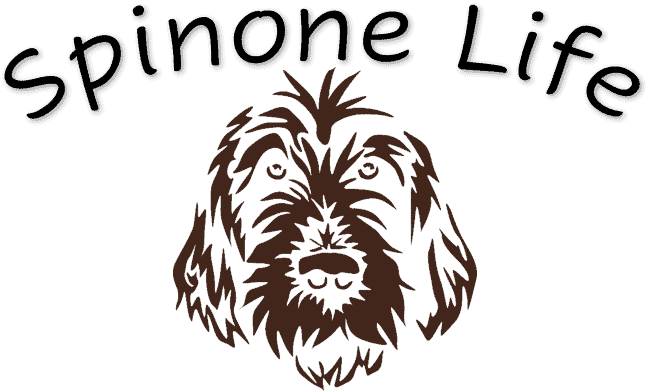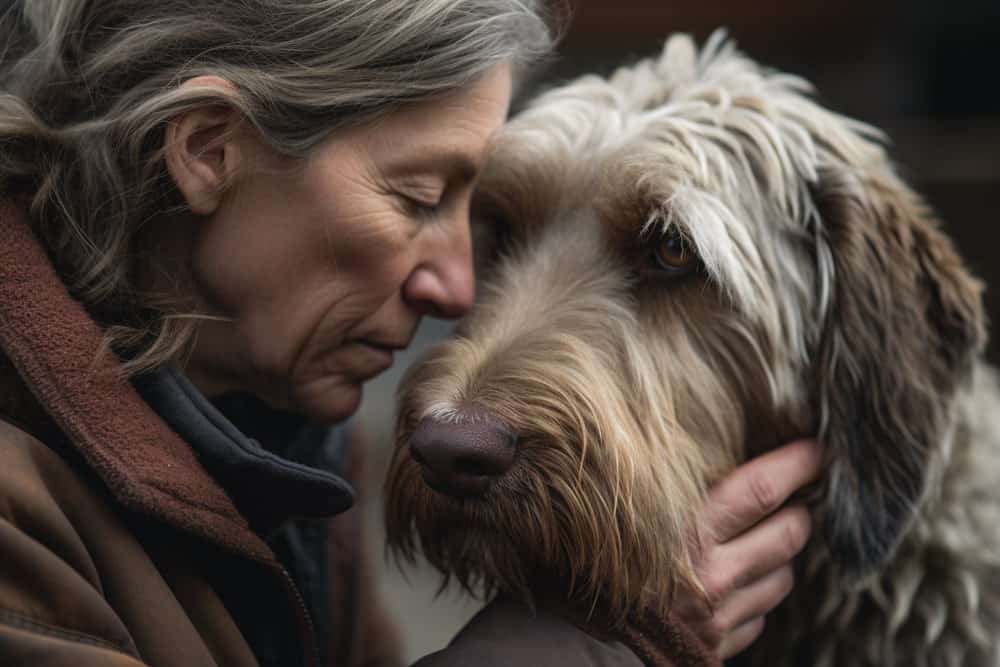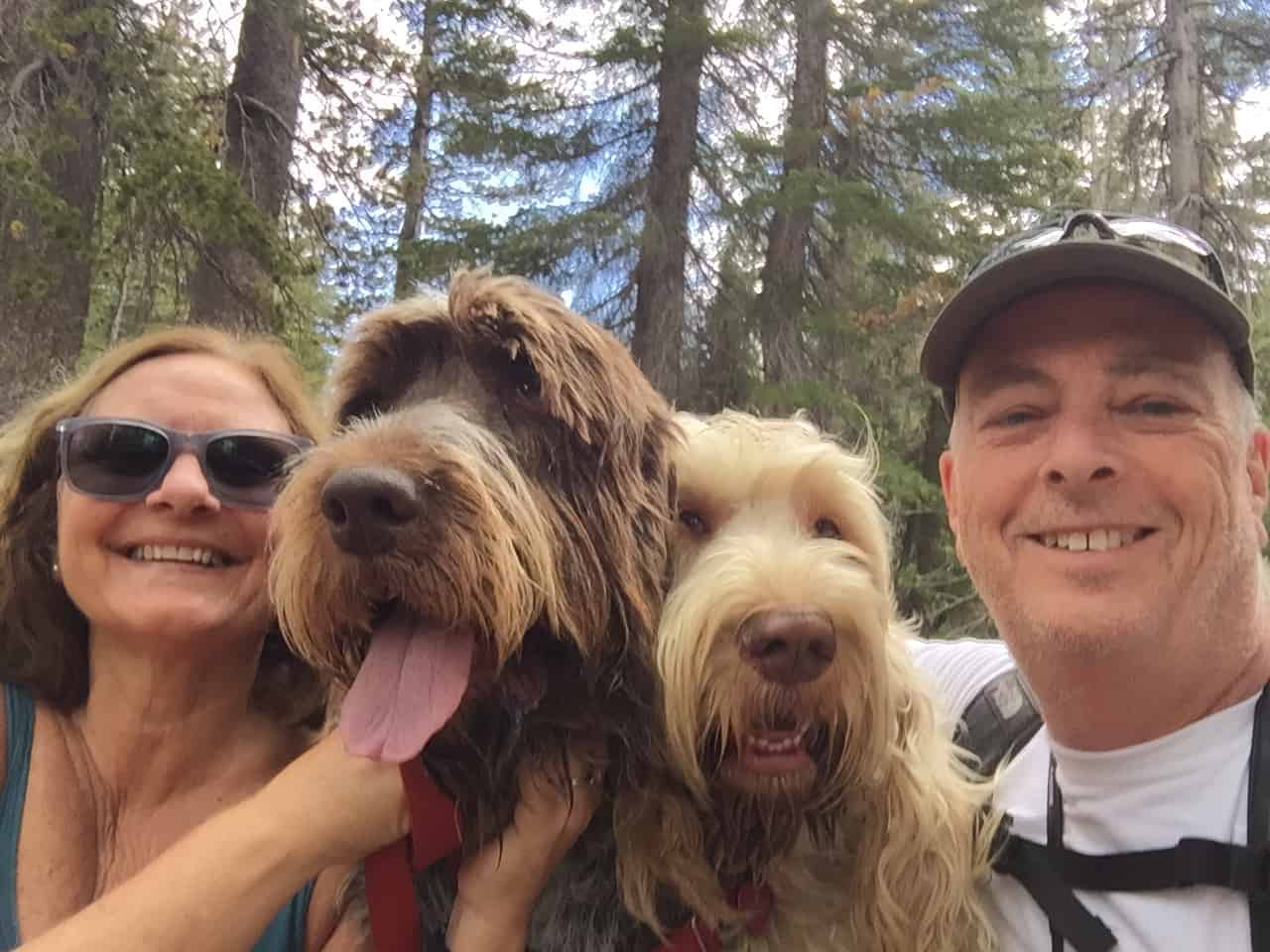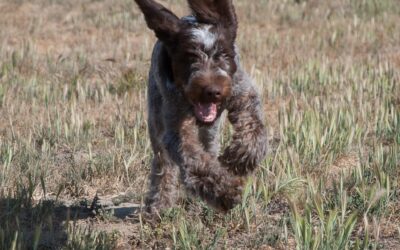Having witnessed canine bloat in a Spinone Italiano firsthand, I can say it’s scary and devastating to see. Fortunately, we were able to get our boy to the vet for emergency surgery and he made a full recovery. If you own a large, deep-chested dog like a Spinone Italiano, you must be aware of the risks of bloat.
Bloat is a life-threatening condition that can affect any dog breed. Large, deep-chested dog breeds, like the Spinone Italiano, are particularly at risk of bloat.
After seeing this happen to our Spinone firsthand, I wanted to learn and understand it better to make sure it doesn’t happen again. So, I did some research to find out more. I hope this never happens to your dog, but learning about what it is, why it happens, and how it’s treated may help your dog survive. Read on for common questions about bloat and some perspectives on the prevention of canine bloat in a Spinone Italiano.
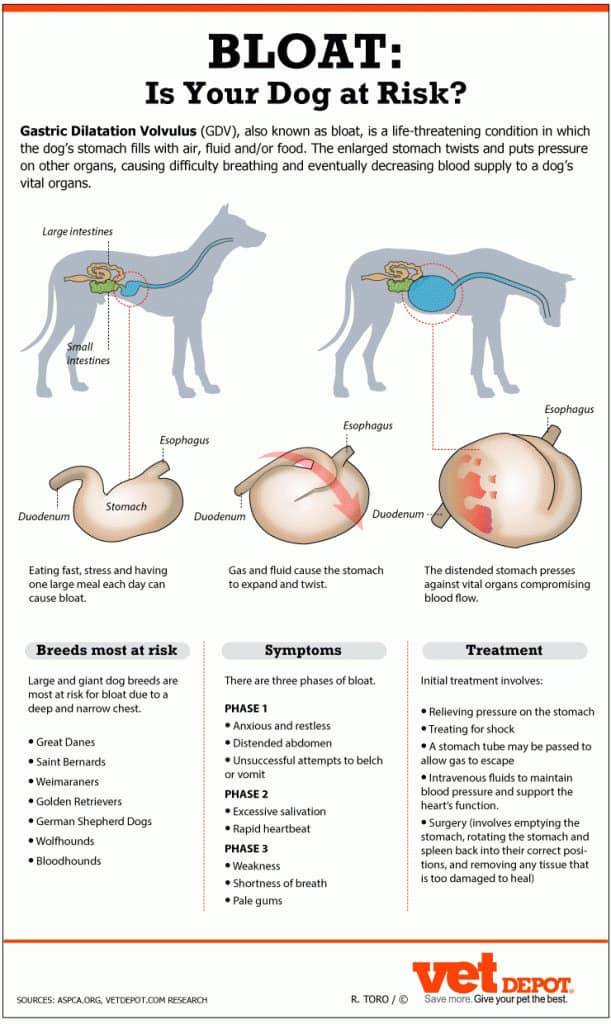
Table of Contents
Dangers of Canine Bloat In a Spinone Italiano
Bloat in dogs is a life-threatening disorder most commonly seen in large, deep-chested dogs like the Spinone Italiano. However, any dog may be affected. In its most technical terms, bloat is gastric dilatation (stomach swelling) and can include volvulus (twisting). In its early stage, the stomach fills with gas, food, or fluid, causing a simple gastric dilatation or “bloat”. Sometimes, the condition progresses no further than bloat.
In some cases, the dog’s stomach will rotate or twist, a condition that vets call gastric dilatation-volvulus (GDV). It traps blood in the stomach and blocks it from returning to the heart and other areas of the body. Once rotated, the gas is unable to escape and continues to build up. This should be considered an emergency that requires surgery to correct. Without prompt treatment, this condition is fatal in almost every case.
The main reason bloat is so dangerous for Spinone and other dogs is that can lead to GDV which is fatal if action isn’t taken immediately. It is a true emergency. If you believe your dog is experiencing bloat, be prepared to drive them to the vet for emergency surgery as soon as absolutely possible. The chance of survival decreases dramatically if you delay getting the dog to the vet more than 60-90 minutes after the first signs.
Another reason bloat is so dangerous is that it develops without warning and can progress very quickly. When this happened to our Spinone, we had hardly noticed something was wrong before realizing he was in serious distress and we needed to act quickly.
Recognize Signs of Bloat in Dogs
Recognizing the signs of bloat is essential to increasing the chances your dog will survive. Signs of bloat can include:
- Gagging, coughing, vomiting, or attempting to vomit. Can appear as unproductive or dry vomiting or vomiting up white foamy mucus. May occur in 5-30 minute intervals.
- Distended Abdomen with a hunched appearance
- Salivating excessively or drooling is an indication of severe pain
- Rapid, Shallow Breathing
- Pale or discolored gums
- Rapid heart rate
- Collapse
- Anxious, pacing, restless – refusal to sit or lie down
- Abdominal swelling may feel tight.
- Whining
- Unproductive attempts to defecate
- Heavy panting
- Lack of normal digestive sounds
- Licking the air
- Seeks a hiding place
- Excessive drinking
Without treatment, in only an hour or two, your dog will likely go into shock. The heart rate will rise and the pulse will get weaker, eventually leading to death.
Canine bloat is also dangerous because veterinarians are not sure what causes it. With Spinoni, males are more likely to bloat than females. Bloat can occur at any age but is most often seen in middle-aged dogs. Research from Purdue University found that risk increased by 20% per year of age. The American College of Veterinary Surgeons states that nearly all breeds have been reported to have had bloat (with or without volvulus), but the condition is seen most commonly in large breed dogs with deep chests.
Here are major factors that raise a Spinone’s risk for bloat:
- If a dog has relatives (parents, siblings, or offspring) who have suffered from bloat, there is a higher chance he will develop bloat.
- Large, deep-chested dog breeds are more prone.
- Dogs are far more likely to bloat again if they have suffered previously.
- Exercise too close to mealtimes
- Stressed dogs and those that are hyperactive are more likely to bloat. Common pre-cursors are car travel, dog shows, going into boarding kennels, having seasons, being around in-season bitches, and mating.
- Fast eaters have five times the risk than dogs that are slow eaters.
- Dogs fed one meal a day are twice as likely to bloat as those fed two meals a day.
- Unhappy or fearful dogs are twice as likely to bloat as those that are happy.
- Foods containing soybean meal or having oils or fats in the first four ingredients increase the risk by four times.
How Is Canine Bloat Treated?
Treatment for bloat should be sought out as soon as possible to increase the dog’s chance of survival. The severity of the case determines the treatment recommendation for the affected dog. The veterinarian’s goal is to get rapid confirmation of diagnosis, attend to patient comfort by releasing as much gas pressure as possible, and provide pain medications. It is vital to get rapid stabilization and preparation for surgery (if needed). Dogs that are bloated without volvulus can normally be treated non-surgically.
In cases where GDV occurs, veterinarians start by treating the shock. Once the dog is stable, he’s taken into surgery. Surgery usually consists of two procedures. The first is to deflate the stomach and turn it back to its correct position. If the stomach wall is damaged, that piece is removed.
Generally, a gastropexy is also performed during the surgical procedure. During a gastropexy, the stomach is sutured to the abdominal wall. This is designed to keep the stomach in place and prevent twisting of the stomach if bloat occurs again. The success rate of preventing the recurrence of a GDV is 95%.
Dogs with GDV who do not receive treatment will not survive. However, up to 80% of dogs that receive prompt treatment for the condition do survive.
Preventing Canine Bloat In a Spinone Italiano
Not all cases of bloat can be prevented. However, by implementing some of the techniques listed below, you may be able to reduce your dog’s risk. If your dog shows signs of bloat, take them to a veterinarian or an emergency pet clinic immediately.
- Pre-emptive gastropexy. This is a surgical procedure where your vet stitches the stomach in place to prevent volvulus (twisting) from occurring. It is the most effective preventative but even so does not provide a 100% guarantee. Dogs that had previously bloated still had a 4.5% recurrence rate after gastropexy.
- Never exercise your dog within an hour on either side of mealtimes.
- Avoid stressful situations where possible, particularly at mealtimes. Where stress cannot be avoided, take steps to reduce it.
- Use slow-feed dog bowls to slow down rapid eaters.
- Check your dog food to see if it contains citric acid or lists fat in the first four items. If so, change it to one that does not. High protein low carbohydrate feeds have been shown to help reduce the risk slightly.
- Do not breed from a dog that has bloated or one whose immediate family members have been known to suffer from bloat. This may not help your dog but it will help future lines of Spinone.
- If your dog bloats, inform your breeder so that they can contact the owners of your dog’s littermates and inform them that they are at greater risk. If you have bred from your dog, inform the owners of the offspring to alert them to the heightened risk.
- If you are away from home with your Spinone, make sure you know the phone number and address of the nearest vet and/or emergency vet clinic. Add this information to your mobile phone. Travel is a major cause of stress for dogs which can, in turn, lead to bloat. Do this for every dog show you attend or vacation you take.
- If you are away from home without your Spinone, make sure whoever is taking care of them knows the signs of bloat and has your veterinarian and emergency pet clinic contact information should an emergency arise.
None of these measures will guarantee that your dog won’t bloat, but they may help reduce the severity of the problem if it does occur.
Be Prepared For Bloat
Any dog can suffer from bloat, so it’s important that you are prepared to recognize this condition and act quickly. It is painful and distressing and will be fatal if not treated by your veterinarian immediately.
To keep your Spinone safe from bloat make sure to do the following:
- Learn the signs of bloat
- Know what to do if your Spinone shows those signs
- Talk to your family veterinarian about how they handle emergencies
- Know where the nearest 24-hour veterinary emergency facility is located
- Talk to your family veterinarian about your dog’s risk for bloat and about the potential for preventative gastropexy
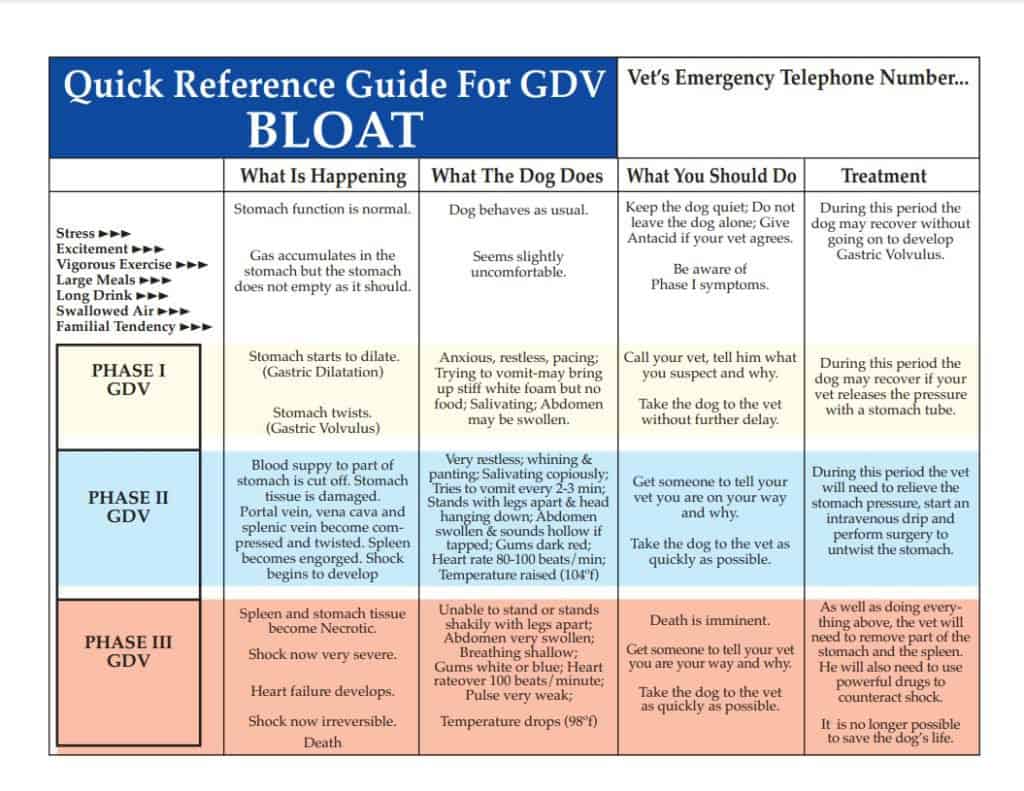
Canine Bloat FAQs
What is canine bloat?
Canine bloat, also known as gastric dilatation-volvulus (GDV), is a life-threatening condition that affects dogs, particularly large and deep-chested breeds like the Spinone Italiano. It occurs when the stomach becomes filled with gas, fluid, or food and twists on its axis, leading to a blockage of blood flow to the stomach and other vital organs.
What should I do if I suspect my Spinone Italiano has bloat?
If you suspect your Spinone Italiano has bloat, it is essential to seek emergency veterinary care immediately. Time is critical when dealing with bloat, and delaying treatment can result in serious complications or even death. Your veterinarian may need to perform emergency surgery to untwist the stomach and restore blood flow to the affected organs.
What causes bloat in a Spinone Italiano?
The exact cause of bloat in dogs is not fully understood, but several factors can contribute to the development of the condition, including genetics, diet, feeding habits, exercise routine, and stress. In deep-chested breeds like the Spinone Italiano, the risk of bloat is higher due to the anatomy of their digestive system.
Can bloat in a Spinone Italiano be prevented?
While bloat cannot be entirely prevented, there are several things that Spinone Italiano owners can do to minimize the risk of their dogs developing the condition. These include feeding small, frequent meals, avoiding exercise or excitement after meals, providing a high-quality, low-fat diet, and reducing stress in the dog’s environment.
What other health issues are common to a Spinone Italiano?
Hip Dysplasia
Eye Problems
Allergies
Bloat
Ear Infections
Cancer
It is essential to work closely with your veterinarian to monitor your Spinone Italiano’s health issues and manage any underlying conditions. Regular wellness exams, proper nutrition, exercise, and preventative care can help keep your dog healthy and happy for many years.
Conclusion
Bloat is a serious condition that requires immediate attention. As a responsible Spinone Italiano owner, it’s crucial to understand the causes, symptoms, and preventive measures to minimize the risk. By implementing proper feeding habits, managing stress levels, and seeking prompt veterinary care, you can help ensure the well-being and longevity of your beloved Spinone companion.
